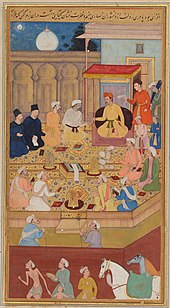Syncretism
Syncretism involves the merging or assimilation of several originally discrete traditions, especially in the theology and mythology of religion, thus asserting an underlying unity and allowing for an inclusive approach to other faiths.Overt syncretism in folk belief may show cultural acceptance of an alien or previous tradition, but the "other" cult may survive or infiltrate without authorized syncresis.[3][4] Syncretism was common during the Hellenistic period, with rulers regularly identifying local deities in various parts of their domains with the relevant god or goddess of the Greek Pantheon as a means of increasing the cohesion of their kingdom.Some religious movements have embraced overt syncretism, such as the case of melding Shintō beliefs into Buddhism or the amalgamation of Germanic and Celtic pagan views into Christianity during its spread into Gaul, Ireland, Britain, Germany and Scandinavia.Conversely, the rejection of syncretism, usually in the name of "piety" and "orthodoxy", may help to generate, bolster or authenticate a sense of uncompromised cultural unity in a well-defined minority or majority.Indeed, critics of a syncretistic trend may use the word or its variants as a disparaging epithet, as a charge implying that those who seek to incorporate a new view, belief, or practice into a religious system pervert the original faith.[7] In modern secular society, religious innovators sometimes construct new faiths or key tenets syncretically, with the added benefit or aim of reducing inter-religious discord.[14] The modern, rational, non-pejorative connotations of syncretism arguably date from Denis Diderot's Encyclopédie articles Eclecticisme and Syncrétistes, Hénotiques, ou Conciliateurs.


Syncretism (linguistics)Syncretic politicsReligious syncretismPersephoneSerapisEgyptianschools of thoughtassimilationtraditionstheologymythologyreligioninclusivecultureeclecticismModern LatinPlutarchMoraliaCretansLahore FortHindu influencesrepresentation of living figuresconversosSpanish InquisitionCatholicismKushiteTwenty-fifth DynastyOsirisKushite rulerAtlanersaJebel BarkalHellenisticGreek PantheonYahwehRoman EmpireGreco-Roman pantheonmelding Shintō beliefs into BuddhismNorth AmericaManitouAlgonquian groupsGod of ChristianityShi'i IslamTrinidadSecond Temple JudaismProtestantintercultural competencerealmsorthodoxycultural unityHellenistic religionHellenistic JudaismChristian influences in IslamNew religious movementsHermanubisTaranisJupiterRomanoCelticAbrahamic religionsexclusivistsecularLiving ChurchSoviet RussiaGerman Evangelical ChurchNazi GermanyMoral syncretismJerry H. BentleyMughal emperorDin-i IlahiHinduismChristianityJainismZoroastrianismpersonality cultMatthew TindalDenis DiderotEncyclopédiecritical thinkingThe Hindu Pantheondisestablishment of religionspiritualismagnosticismatheistsConfederacyConflationCultural appropriationCultural assimilationMulticulturalismMultiple religious belongingNew religious movementReligious pluralismDictionary.com UnabridgedOxford English DictionaryOxford University PressTurner, MaxEncyclopædia BritannicaAssmann, JanSmith, Mark S.

